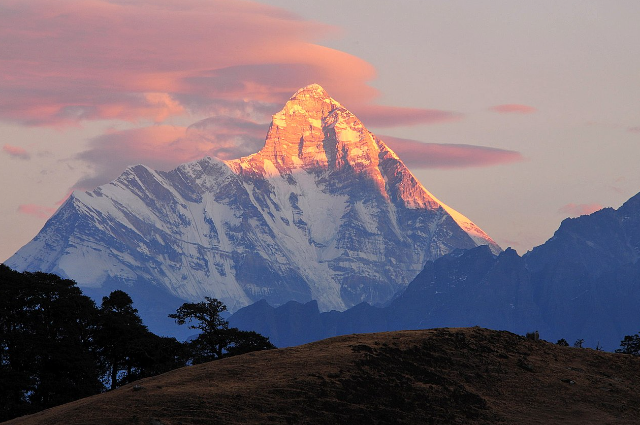
Nanda Devi Mountain Exploration
The state of Uttarakhand in northern India is often referred to as devbhumi, which means land of the Gods. Besides numerous Hindu and Buddhist temples and pilgrimage centres, the region contains many high peaks that belong to the Garhwal and Kumaon Himalaya.
Since the 19th century, the beauty of the mountains has attracted many mountaineers. Nanda Devi is the second-highest mountain in India after 8,586m Kangchenjunga, and the highest one that is located entirely within the country. The blessed Goddess, 7,816m Nanda Devi, also has a lower, eastern summit, called Nanda Devi East or Sunanda Devi. A ridge almost three kilometres long and nearly 7,000m high connects the two summits. The Goddess Nanda Devi is the most important of the Hindu deities in Garhwal. In the region, drained by the Rishi Ganga and the Dhauli Ganga, every nook and cranny seems in one way or another to be dedicated to her. The highest and most impressive mountain of the region, Nanda Devi, bears her name; other peaks also bear her name.
The Story of Nanda Devi
A beautiful young princess, named Nanda, the daughter of the king of the Chanda dynasty of Chamoli, ran for her life to escape the wily Rohilla prince, who was chasing her. He was madly in love with her. As her father refused to give her in marriage to him, he waged war against the Kumaon king and defeated him. To save herself, Nanda Devi climbed onto the snowy pinnacles and merged with the holy mountain. This Mountain came to be revered as a temple for Nanda Devi. She is an angry goddess who is believed to be an avatar of Durga. Every activity, whether it’s a village festival or a special family event, will always begin with an offering that ranges from simple stones, coins, and flowers to animals. During the Treta Yuga, when Lakshmana fell unconscious on the battlefield, Hanuman’s search for the Sanjeevini herb took him to the dunagiri mountain in the Chamoli district in Almora. Unable to identify the herb, Hanuman broke off a piece of the mountain, without obtaining permission from Goddess Nanda, and carried it off to Sri Lanka.
The Goddess became angry and passed a decree that anybody who utters a human's name will be severely punished. Hence, there are no shrines dedicated to Hanuman in these parts. Interestingly, parts of the Dunagiri mountain seem to have fallen along this route. One part is believed to exist even today, near Nagarcoil. It’s popularly known as Marundhu vazh malai. Curiously, the shape of the hill will replicate Hanuman facing upwards.
The river Rishi Ganga begins with the glacier called Uttari Nanda Devi. The Dakshini Nanda Devi glacier also feeds it. Rishi Ganga flows through the Nanda Devi National Park and then into the Dhauli Ganga river, established in 1982. The peak and surrounding mountains have been closed to other locals and foreign climbers owing to their religious significance and for the protection of their fragile system.
Hidden History or Mystery?
From 1965 through 1968 CIA collaborated with the Indian intelligence bureau to train some of the most elite climbers to install a nuclear power sensing Device on the Nanda Peak. This would eavesdrop on China’s burgeoning nuclear ambitions that were being worked upon in full force in the neighbouring Xinjiang province. The plan was to intercept radio telemetry signals from the Chinese ground control through a transceiver, which would then transfer this information to the CIA station. This transceiver was powered by a system for nuclear auxiliary power, turning radioactive heat into electricity. The battery was made of a plutonium alloy, radioactive in nature, with an expected longevity of more than a century. This device weighed more than 50kg, half the size of an atom bomb dropped in Hiroshima. When the expedition team was about to reach the summit, the weather had turned worse, and an avalanche was predicted. The expedition leader, Manmohan Sigh Kohli, had the option to save either the men or the machine. He decided to save the men. And thus, the plutonium-laden device gets pulverised in the avalanche, and is said to be slowly making its way towards the headwaters of the Ganges ever since. Kohli expected a heavy contamination of the river. Affecting the lives of people living as far as Kolkata. The waters of Rishi Ganga, which drain Nanda Devi glacier, and the Ganges were tested multiple times for radiation and contamination, but nothing was found.
Again in 1968, the Indo-American spy team successfully installed another device on the shoulder of the adjoining peak, Sunanda Devi. After repeated blizzards and snowstorms, the device got submerged in snow, only to be retrieved two months later with absolutely no intel. Thus, rendering the entire mission futile. Owing to the activities of the CIA, the Nanda Devi peak and its surrounding areas were closed for foreign expeditions. It opened in the year 1973, only to be closed again from 1983.
In the year 1968, Nanda Devi National Park was declared a UNESCO World Heritage site, “of outstanding cultural or natural importance to the common heritage of humankind.” Nanda Devi owes her charm not only to her height or setting, but also to the fact that amid these icy flakes lies a terrifying vestige of the Cold War’s most daring adventure, a vestige that could threaten the lives of millions.
Nanda Devi remains a powerful force to reckon with, one of the toughest mountains to climb, and only God and the mountain herself know what’s happening up there and with the still missing plutonium. The fact that Nanda Devi remains off limits to most people is a good thing. Not just for the conservation of the fragile mountain ecosystem, but also for the unknown dangers that lie buried somewhere on the mountain.
. . .
References:
- Wikipedia.org
- The Hindu
